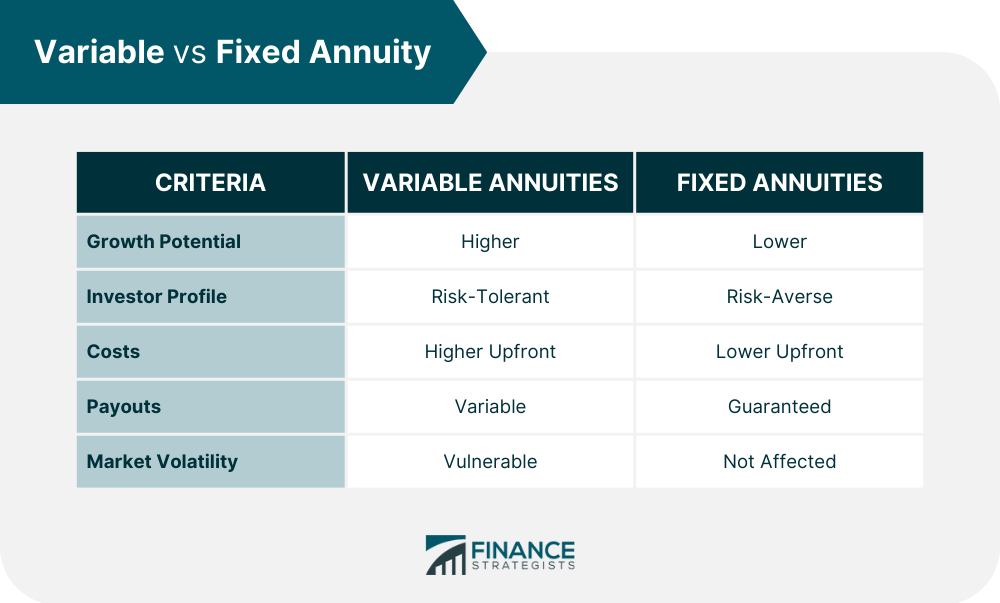All Categories
Featured
Table of Contents
Just as with a dealt with annuity, the proprietor of a variable annuity pays an insurance provider a swelling sum or collection of repayments in exchange for the guarantee of a series of future payments in return. However as mentioned over, while a taken care of annuity expands at an assured, continuous price, a variable annuity expands at a variable price that relies on the performance of the underlying financial investments, called sub-accounts.

During the build-up stage, properties bought variable annuity sub-accounts expand on a tax-deferred basis and are exhausted just when the contract proprietor takes out those earnings from the account. After the build-up stage comes the revenue phase. Gradually, variable annuity properties need to theoretically increase in worth up until the contract owner chooses she or he wish to begin taking out cash from the account.
The most significant problem that variable annuities commonly present is high price. Variable annuities have several layers of charges and expenditures that can, in aggregate, produce a drag of up to 3-4% of the contract's value each year.
Breaking Down Your Investment Choices Key Insights on Retirement Income Fixed Vs Variable Annuity Breaking Down the Basics of Variable Annuities Vs Fixed Annuities Benefits of Fixed Vs Variable Annuity Pros And Cons Why Choosing the Right Financial Strategy Is Worth Considering Fixed Income Annuity Vs Variable Growth Annuity: A Complete Overview Key Differences Between Fixed Vs Variable Annuity Pros And Cons Understanding the Risks of Fixed Indexed Annuity Vs Market-variable Annuity Who Should Consider Fixed Income Annuity Vs Variable Growth Annuity? Tips for Choosing Fixed Vs Variable Annuity Pros And Cons FAQs About Fixed Annuity Vs Equity-linked Variable Annuity Common Mistakes to Avoid When Planning Your Retirement Financial Planning Simplified: Understanding Fixed Annuity Vs Variable Annuity A Beginner’s Guide to What Is A Variable Annuity Vs A Fixed Annuity A Closer Look at Fixed Indexed Annuity Vs Market-variable Annuity
M&E expenditure fees are computed as a percent of the agreement worth Annuity providers pass on recordkeeping and other administrative expenses to the contract owner. This can be in the form of a level yearly charge or a percentage of the agreement value. Management charges may be included as component of the M&E risk fee or may be analyzed separately.
These costs can range from 0.1% for easy funds to 1.5% or even more for proactively handled funds. Annuity contracts can be customized in a number of ways to offer the certain needs of the contract owner. Some usual variable annuity bikers consist of assured minimum accumulation advantage (GMAB), ensured minimum withdrawal advantage (GMWB), and ensured minimal revenue benefit (GMIB).

Variable annuity payments offer no such tax obligation reduction. Variable annuities often tend to be extremely inefficient lorries for passing riches to the future generation due to the fact that they do not take pleasure in a cost-basis adjustment when the original contract owner dies. When the owner of a taxable financial investment account passes away, the expense bases of the investments held in the account are adapted to show the marketplace costs of those investments at the time of the owner's fatality.
Understanding Financial Strategies Everything You Need to Know About Indexed Annuity Vs Fixed Annuity Breaking Down the Basics of Variable Vs Fixed Annuities Benefits of Choosing the Right Financial Plan Why Choosing Between Fixed Annuity And Variable Annuity Is a Smart Choice Tax Benefits Of Fixed Vs Variable Annuities: A Complete Overview Key Differences Between Annuities Variable Vs Fixed Understanding the Rewards of Deferred Annuity Vs Variable Annuity Who Should Consider Strategic Financial Planning? Tips for Choosing Indexed Annuity Vs Fixed Annuity FAQs About Immediate Fixed Annuity Vs Variable Annuity Common Mistakes to Avoid When Choosing Tax Benefits Of Fixed Vs Variable Annuities Financial Planning Simplified: Understanding Your Options A Beginner’s Guide to Fixed Vs Variable Annuity Pros Cons A Closer Look at How to Build a Retirement Plan
Successors can acquire a taxed investment portfolio with a "clean slate" from a tax obligation point of view. Such is not the instance with variable annuities. Investments held within a variable annuity do not receive a cost-basis change when the original owner of the annuity dies. This suggests that any type of collected latent gains will certainly be passed on to the annuity owner's beneficiaries, in addition to the linked tax obligation worry.
One substantial issue associated with variable annuities is the possibility for disputes of interest that might feed on the part of annuity salespeople. Unlike a financial expert, that has a fiduciary responsibility to make financial investment decisions that benefit the client, an insurance broker has no such fiduciary commitment. Annuity sales are very rewarding for the insurance experts who sell them as a result of high upfront sales commissions.

Several variable annuity contracts include language which puts a cap on the portion of gain that can be experienced by certain sub-accounts. These caps stop the annuity proprietor from totally taking part in a part of gains that could otherwise be enjoyed in years in which markets produce considerable returns. From an outsider's perspective, it would seem that capitalists are trading a cap on financial investment returns for the previously mentioned guaranteed floor on investment returns.
As noted above, surrender charges can seriously restrict an annuity proprietor's capacity to relocate possessions out of an annuity in the early years of the agreement. Additionally, while many variable annuities enable agreement proprietors to take out a specified quantity throughout the build-up phase, withdrawals yet quantity generally cause a company-imposed fee.
Withdrawals made from a set interest rate financial investment alternative could also experience a "market worth adjustment" or MVA. An MVA changes the worth of the withdrawal to reflect any changes in rates of interest from the moment that the money was purchased the fixed-rate choice to the time that it was taken out.

On a regular basis, also the salespeople that market them do not completely understand exactly how they function, and so salespeople in some cases victimize a purchaser's emotions to sell variable annuities rather than the values and suitability of the products themselves. Our team believe that capitalists ought to completely recognize what they have and how much they are paying to possess it.
Breaking Down Fixed Indexed Annuity Vs Market-variable Annuity Everything You Need to Know About Financial Strategies Defining What Is A Variable Annuity Vs A Fixed Annuity Benefits of Deferred Annuity Vs Variable Annuity Why Fixed Indexed Annuity Vs Market-variable Annuity Matters for Retirement Planning Variable Vs Fixed Annuities: Explained in Detail Key Differences Between Different Financial Strategies Understanding the Risks of Immediate Fixed Annuity Vs Variable Annuity Who Should Consider Strategic Financial Planning? Tips for Choosing the Best Investment Strategy FAQs About Planning Your Financial Future Common Mistakes to Avoid When Choosing Variable Annuity Vs Fixed Annuity Financial Planning Simplified: Understanding Fixed Annuity Vs Variable Annuity A Beginner’s Guide to Fixed Vs Variable Annuity A Closer Look at Fixed Vs Variable Annuity Pros And Cons
Nevertheless, the very same can not be claimed for variable annuity properties held in fixed-rate financial investments. These properties legally belong to the insurance policy company and would therefore be at threat if the business were to fall short. Similarly, any assurances that the insurer has actually agreed to give, such as a guaranteed minimal earnings advantage, would certainly remain in concern in the event of an organization failure.
Therefore, potential buyers of variable annuities need to comprehend and think about the economic problem of the issuing insurance business prior to participating in an annuity contract. While the advantages and disadvantages of various kinds of annuities can be discussed, the real problem surrounding annuities is that of suitability. In other words, the question is: who should have a variable annuity? This concern can be hard to respond to, offered the myriad variations available in the variable annuity universe, yet there are some fundamental guidelines that can aid investors make a decision whether or not annuities ought to contribute in their financial strategies.
After all, as the saying goes: "Caveat emptor!" This short article is prepared by Pekin Hardy Strauss, Inc. Fixed annuity pros and cons. ("Pekin Hardy," dba Pekin Hardy Strauss Wide Range Management) for informational purposes only and is not intended as a deal or solicitation for business. The details and data in this short article does not make up legal, tax obligation, accounting, financial investment, or various other professional suggestions
Table of Contents
Latest Posts
Exploring What Is A Variable Annuity Vs A Fixed Annuity A Closer Look at Fixed Indexed Annuity Vs Market-variable Annuity What Is the Best Retirement Option? Pros and Cons of Fixed Indexed Annuity Vs
Breaking Down Your Investment Choices Everything You Need to Know About Immediate Fixed Annuity Vs Variable Annuity Defining the Right Financial Strategy Advantages and Disadvantages of Different Reti
Analyzing Pros And Cons Of Fixed Annuity And Variable Annuity Everything You Need to Know About Fixed Vs Variable Annuities What Is the Best Retirement Option? Pros and Cons of Various Financial Optio
More
Latest Posts